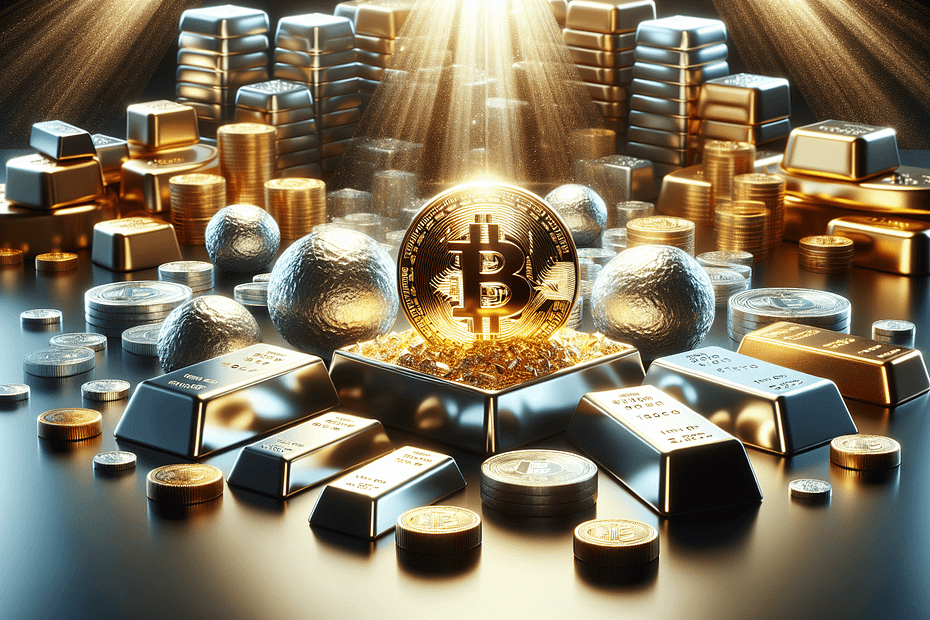Are you ready to explore the exciting world of alternative assets? In this article, we will uncover the key considerations for investing in alternative assets, with a specific focus on cryptocurrencies and precious metals. As traditional investment avenues become increasingly saturated, many individuals are turning to alternative assets as a means to diversify their portfolios and potentially enhance their returns. Whether you’re intrigued by the volatility and innovation of cryptocurrencies or enticed by the illustrious history and inherent value of precious metals, it’s crucial to understand the unique aspects and risks associated with these alternative investments. So, let’s dive into the fascinating realm of alternative assets and discover what factors you need to consider before making that investment leap.
Volatility
Cryptocurrencies
When it comes to volatility, cryptocurrencies are known for their wild price swings. The value of cryptocurrencies can change dramatically within a short period of time, making them a high-risk investment. This volatility can be attributed to several factors, including market speculation, regulatory developments, and technological advancements. If you choose to invest in cryptocurrencies, it’s important to be prepared for the possibility of significant fluctuations in value.
Precious Metals
On the other hand, precious metals like gold and silver are generally considered to be more stable and less volatile than cryptocurrencies. While their prices can still fluctuate, these fluctuations are typically less extreme compared to cryptocurrencies. Precious metals have been valued for centuries and have a long history of being a reliable store of wealth. Investing in precious metals can provide a sense of stability and security in times of market volatility.
Liquidity
Cryptocurrencies
Cryptocurrencies offer a high level of liquidity, as they can be easily bought and sold on various cryptocurrency exchanges. This means that you can quickly convert your cryptocurrency holdings into cash if needed. However, it’s important to note that liquidity can vary between different cryptocurrencies and exchanges. Some smaller or less popular cryptocurrencies may have lower liquidity, which can make it more challenging to buy or sell them at desired prices.
Precious Metals
Similarly, precious metals also offer a good level of liquidity. Gold and silver, in particular, have a well-established global market, with numerous buyers and sellers. This makes it relatively easy to convert your precious metal holdings into cash when necessary. Additionally, there are several reputable dealers and platforms that facilitate the buying and selling of precious metals, providing investors with a convenient way to access the market.
Value
Cryptocurrencies
The value of cryptocurrencies is primarily determined by market demand and sentiment. Unlike traditional assets like stocks or bonds, cryptocurrencies do not generate cash flow or pay dividends. Instead, their value is largely driven by speculation and perceived utility. This can make it difficult to determine the intrinsic value of a cryptocurrency, as it is largely influenced by market sentiment and investor behavior.
Precious Metals
In contrast, the value of precious metals is influenced by a variety of factors, including supply and demand dynamics, geopolitical events, and macroeconomic trends. Precious metals have intrinsic value due to their use in various industries and their history as a reliable store of wealth. Gold, for example, has been valued throughout human history and is often seen as a safe haven asset during times of economic uncertainty.
Security
Cryptocurrencies
Security is a major concern when it comes to cryptocurrencies. While blockchain technology provides a secure and transparent decentralized system, individual wallets and cryptocurrency exchanges can still be vulnerable to hacks and cyber attacks. It is crucial to take proper security measures, such as using hardware wallets, implementing strong passwords, and being cautious of phishing attempts. Additionally, the lack of regulatory oversight in the cryptocurrency space can also contribute to security risks.
Precious Metals
When it comes to security, precious metals are often considered to be a safe investment. Physical metals can be stored in secure vaults or personal safes, reducing the risk of theft or loss. However, it’s important to ensure that proper security measures are in place, especially when dealing with larger quantities of precious metals. Additionally, purchasing precious metals from reputable dealers can help mitigate the risk of counterfeit products.
Regulation
Cryptocurrencies
Regulation in the cryptocurrency space is still evolving. Different countries have varying approaches to cryptocurrency regulation, ranging from strict regulations to more lenient or even a lack of regulations. The lack of consistent global regulations can create uncertainty and potential risks for cryptocurrency investors. It’s important to stay informed about the regulatory landscape and be aware of the potential impact of regulatory changes on cryptocurrency investments.
Precious Metals
Precious metals, on the other hand, have a well-established regulatory framework. Governments and international bodies have implemented regulations to ensure the integrity of the precious metals market and protect consumers. These regulations cover areas such as mining, trading, and taxation. The existence of regulations can provide investors with a certain level of confidence and transparency when investing in precious metals.
Market Accessibility
Cryptocurrencies
Cryptocurrencies have gained popularity in part due to their accessibility. Anyone with an internet connection and a digital wallet can participate in the cryptocurrency market. This accessibility allows for a global reach and participation, irrespective of geographical location or financial background. However, it’s important to note that not all cryptocurrencies are equally accessible or available on all platforms or exchanges.
Precious Metals
Investing in precious metals can also be relatively accessible. Precious metals can be purchased through various channels, including reputable dealers, online platforms, and even some financial institutions. However, physical possession of precious metals may require additional considerations, such as storage and insurance. It’s essential to evaluate the accessibility options and associated costs before investing in precious metals.
Diversification
Cryptocurrencies
Cryptocurrencies can provide an opportunity for diversification within one’s investment portfolio. By adding cryptocurrencies to a traditional portfolio of stocks and bonds, investors can potentially reduce their overall risk exposure. Cryptocurrencies have shown low correlation with other asset classes, meaning their price movements are often independent of traditional financial markets. However, it’s important to carefully consider the risk-return characteristics of cryptocurrencies before incorporating them into a diversified portfolio.
Precious Metals
Similarly, precious metals can also offer diversification benefits. Precious metals have a history of being negatively correlated with traditional financial assets during times of economic uncertainty. This means that when traditional markets experience declines, the value of precious metals may increase, providing a potential hedge against market volatility. Adding precious metals to a portfolio can help balance the overall risk and potentially enhance long-term returns.
Long-term Outlook
Cryptocurrencies
The long-term outlook for cryptocurrencies is a topic of debate and speculation. Some enthusiasts believe that cryptocurrencies have the potential to revolutionize the financial industry and become a mainstream form of digital currency. Others are more skeptical and highlight the risks and uncertainties surrounding cryptocurrencies. Factors such as technological advancements, regulatory developments, and market adoption will play significant roles in shaping the long-term outlook for cryptocurrencies.
Precious Metals
Precious metals have stood the test of time and continue to be valued by investors. The demand for precious metals is driven by various factors, including industrial use, jewelry, and investment purposes. While the long-term outlook for precious metals may be influenced by economic and geopolitical factors, their historical performance suggests that they are likely to remain a viable store of wealth and a potential hedge against inflation and economic uncertainties.
Expertise
Cryptocurrencies
Investing in cryptocurrencies requires a certain level of expertise and understanding of the technology and market dynamics. Cryptocurrencies are complex assets that operate on blockchain technology, and staying informed about developments in the space is crucial. It’s important to conduct thorough research, understand the fundamentals of different cryptocurrencies, and stay updated on market trends and regulatory changes when investing in cryptocurrencies.
Precious Metals
Investing in precious metals also requires some level of expertise, although it may be more accessible to beginner investors. Understanding the factors that drive the price of precious metals, such as supply and demand dynamics or macroeconomic trends, can help make informed investment decisions. Additionally, staying informed about reputable dealers, storage options, and market trends can help ensure a successful investment in precious metals.
Risk Tolerance
Cryptocurrencies
Investing in cryptocurrencies requires a higher risk tolerance due to their volatile nature. The potential for significant price swings and the lack of regulatory oversight can result in substantial losses. It’s important to assess your risk tolerance and understand that investing in cryptocurrencies carries a higher level of risk compared to traditional investments. Diversification and careful risk management strategies can help mitigate some of the risks associated with cryptocurrency investments.
Precious Metals
Investing in precious metals is generally considered to be less risky compared to cryptocurrencies. While their prices can still fluctuate, the historical stability and long-standing value of precious metals provide a level of reassurance for investors. Precious metals can be seen as a safer option for investors with lower risk tolerance or those looking for a more conservative investment strategy.
In conclusion, investing in alternative assets such as cryptocurrencies and precious metals requires careful consideration of various factors. Both cryptocurrencies and precious metals have their unique characteristics and risks. Volatility, liquidity, value, security, regulation, market accessibility, diversification, long-term outlook, expertise, and risk tolerance are all essential considerations when making investment decisions. Understanding the similarities and differences between these alternative assets can help investors make informed choices that align with their financial goals and risk tolerance levels.





